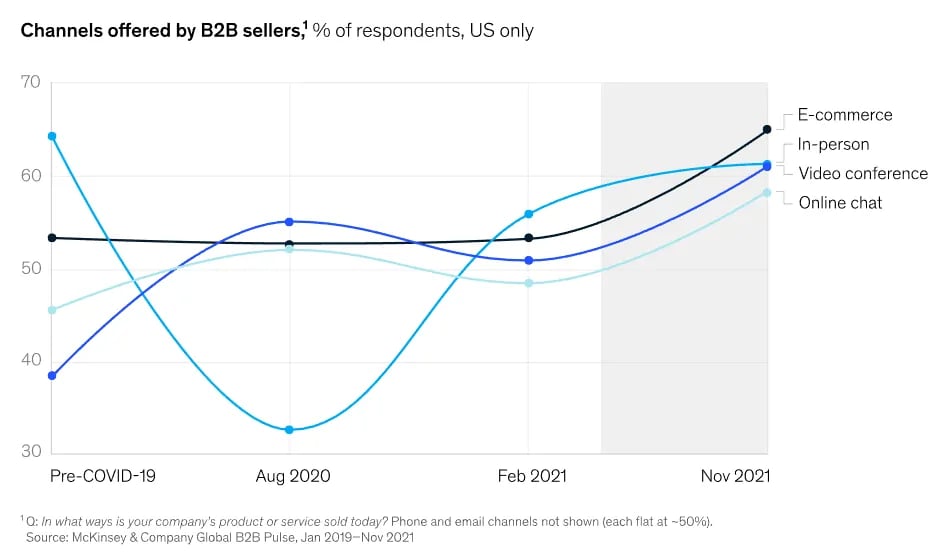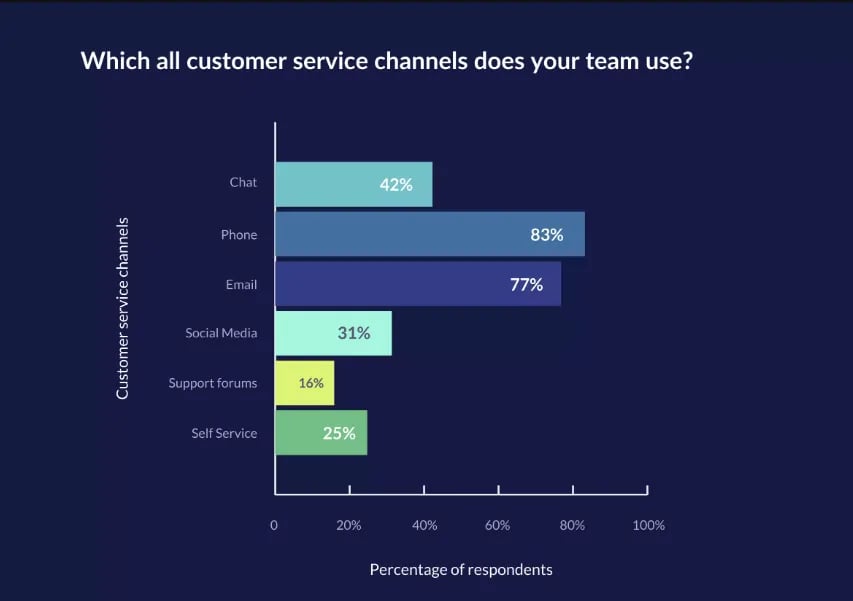The B2B market has exponentially grown over the years. Statista projects an estimated 17% of all B2B sales to be generated digitally in 2023. As this industry shows no signs of slowing down, capitalizing on its market growth is best.
Unfortunately, staying ahead of the competition can be daunting in today’s business landscape. With new technologies and business trends emerging, one must deeply understand the present and future B2B sales. More importantly, keeping up with these technologies and trends is crucial for gaining a competitive advantage.
This blog post will share how to boost your B2B sales for growth and success. But first, let’s explore the industry's current and future digital sales.
The current state and future of digital sales in the B2B market
The digital sales landscape is in a state of constant evolution. The rise of online businesses and remote selling has made it easier for companies to purchase products and hire services from one another. McKinsey & Company research reported that 65% of B2B companies were exclusively selling online last year.

Thanks to technological advancements, digital tools, and technologies have reshaped the B2B sales landscape. The internet has paved the way for digital sales rooms, where companies now do business with each other online. Likewise, automation streamlines sales processes, increases service efficiency, and reduces operating costs.
And fast forward to the future. It's clear to see that the B2B sales landscape will continue to evolve. With continuous technological innovations, companies should adapt to new tools and technologies to stay competitive.
For one, they should consider outsourcing to third-party vendors to penetrate the worldwide market and stay globally competitive. They should also prepare for digital currencies like cryptocurrency and blockchain technology for increased security, transparency, and efficiency in B2B transactions.
Additionally, virtual reality (VR) and augmented reality (AR) in sales will provide new ways to interact with clients. Although nearly 20% said engaging customers in virtual environments is one of their top challenges, digital rooms can be a tool rather than a hindrance.
Jarret Austin, Owner of Bankruptcy Canada Inc, underscores the importance of prioritizing customers. “Everything doesn't matter if your customers are dissatisfied and unhappy. Remember, the customers are your most important stakeholders. Understand and meet their needs so your business will grow and won’t go bankrupt.”
How to increase your B2B sales long-term
The B2B sales market offers entrepreneurs the golden opportunity to grow their businesses. However, this growing market might become overly saturated, and the competition might become stiff someday. Therefore, you should find ways to boost your sales and stay ahead of the competition.
Here's how to increase your B2B sales long-term:
1. Optimize your business website
Having a well-designed and well-structured website is crucial for driving sales in the B2B world. Here’s how you can optimize your site:
- Regular website audits: Performing site audits helps identify and fix technical issues. These include slow loading time, broken links, and incorrect information.
- Responsive web design: Responsive web design ensures your website adapts to the screen size and resolution of the device used to access it. Optimize your site for all devices, including smartphones and tablets.
- Quality web host: A quality web host can do a lot to optimize your website, as they’ll ensure your website is lightning-fast, reliable, and completely secure. Web hosting services like NameHero can even set you up with a free domain.
- Mobile optimization: Mobile optimization is simply optimizing your website for mobile devices. You want to ensure your site has features like fast loading, easy navigation, and excellent user experience (UX).
Tory Jon, the Founder of Camper FAQs, believes website optimization is the first step in driving B2B sales. “This will increase your search engine rankings and web presence, making it easier for prospects to find and engage with your business. Before you can even generate sales, your potential clients should find your site first.”
2. Understand your target market and meet client needs
As mentioned above, your clients are your most important stakeholders in the business world. Without them, you won’t generate sales, and your business will cease to exist. As such, it’s crucial to study your target market as the second step for driving sales. Here are a few strategies:
- Conduct market research: Market research provides valuable insights into your target market, including demographics, consumer behavior, and buying habits.
- Establish client personas: Creating customer personas helps you understand the specific needs and pain points of different segments of your target market.
- Consider customer feedback: Listening to customer feedback lets you identify their needs and wants.
By understanding your target market, you’ll meet the business needs of your potential clients. That can translate into increased sales and client satisfaction.
3. Employ effective sales and marketing strategies
After performing research and due diligence on your target market, it’s time to implement sales methodologies and marketing strategies. Here are a few key recommendations:
Sales strategies:
- Solution selling: This strategy focuses on understanding and addressing your client's specific needs and pain points. So, you should present customized solutions best suited to their needs.
- Consultative selling: This strategy helps you build a partnership with the client. You’ll then serve as their trusted advisor.
- Strategic selling: This strategy entails pursuing long-term opportunities to build strategic relationships with key customers and grow the business.
Marketing strategies:
- Search engine optimization: SEO entails optimizing your website to get the top spot on the search engine results pages (SERP). It aims to increase your online visibility and improve E-E-A-T and website traffic through content creation.
- Pay-per-click advertising: PPC has the same goals as SEO—for web presence and traffic. However, this is a form of paid advertising, where you pay for every successful ad click.
- Content marketing: Content will always be king in the digital world and an integral part of digital marketing strategy. As such, this strategy entails creating and publishing valuable and relevant content. The goal is to attract and engage a clearly defined audience, thus ultimately driving profitable client action.
Morgan Taylor, Co-Founder at Jolly SEO, recommends robust sales and marketing strategies. “There are various B2B strategies at your disposal. However, the secret to effective implementation is to study your target market, focus on their needs, and tailor-fit your strategies to their needs. And for the most part, you’ll have to make some necessary tweaks here and there.”
4. Ensure data security and privacy
In the B2B realm, it’s not just about generating sales; it’s about safeguarding your business and clients. Thus, set privacy and security measures to protect your business data and customer information. Here are a few strategies to prevent cyberattacks:
- Password attack: This happens when an attacker attempts to gain access to your account by cracking the password. To address this, implement strong password policies, such as requiring complex passwords, regularly changing them, and using multi-factor authentication.
- Phishing attack: This occurs when an attacker sends an email that appears to be from a legitimate source to trick the recipient into providing sensitive information. To mitigate this, educate your employees on identifying and stopping phishing attempts. Also, use anti-phishing software to detect and block phishing emails.
- Malware attack: This involves using malicious software to gain unauthorized access to a computer or network. It's vital to keep all software and operating systems updated with the latest security patches and use anti-malware software to detect and remove malware from their systems.
Overall, ensuring network security and data privacy is crucial for building trust with clients and maintaining a positive business reputation.
5. Provide clients with omnichannel solutions
Omnichannel solutions have become a norm in business. According to Hiver’s 2021 report, 60% of service teams offer support via more than two channels. Topping the list is phone service at 83%, followed by email and chat support at 77% and 43%, respectively. Here’s how you can leverage multi-channel solutions for your B2B client support:
- Phone: Phone calls are the best way to communicate with your clients, whether answering inquiries or making transactions.
- Email: Allow your clients to reach out to you via email, whether asking for details or getting updates.
- Chat: This channel enables clients to communicate with your business in real time, whether for immediate assistance or customer support.

Mark Pierce, CEO of the Colorado LLC Attorney, believes in the power of communication in business. “Providing clients with various communication channels is crucial for providing a seamless experience and building trust. Not only do they ensure robust communication, but they also help you avoid misunderstandings, conflicts, and even legal ramifications.”
6. Leverage the latest digital tools and technology
Companies of all sizes can no longer ignore the power of digital tools and technology in business. Technical resources provide companies with powerful ways to increase sales and stay ahead of the competition. They also help reduce costs, improve efficiency, and enhance the client experience. Here are digital tools and technologies to consider for your B2B sales:
- Digital sales rooms: These microsites enable sales teams to communicate and collaborate with prospects and customers in real time, offering a unique buying experience. Business is conducted from start to finish on the same platform, and salespeople can share anything from proposals to case studies and testimonials, white papers, and even personalized introduction videos.
- Automation: This technology accelerates processes and reduces manual work by performing repetitive tasks, such as data entry, scheduling, and lead generation. Sales automation will help save you time and money when doing business with other companies. For example, the Dealfront go-to-market platform will automatically pull leads from your website using its Web Visitor Tracking feature.
- Blockchain and cryptocurrency: Blockchain technology is a decentralized and distributed digital ledger that records transactions across multiple computers. This technology can help with the security and transparency of your B2B transactions. Your clients can also use digital currencies, like cryptocurrency, to facilitate B2B transactions with new security and efficiency levels. As this technology gains wider adoption, it is crucial to invest in web3 training to stay ahead of the curve and harness its potential benefits.
- Monitoring and observability: In our technological world, IT staff are considered the first and last line of defense against cyberattacks. IT departments need to monitor (stay alert for performance issues) and observe (figure out the root cause of problems) their systems 24/7 to keep them safe. Software like SolarWinds' observability hybrid cloud technology allows teams to effortlessly visualize, observe, and remediate their environment using automation and key insights. This gives IT staff the agility to tackle any online-based disruption.
7. Consider outsourcing functions
Outsourcing is a viable solution for scaling your operation and growing your company. Working with a third-party vendor allows you to tap a global talent pool and access advanced technology. It also helps reduce your operating costs while maximizing your sales revenues. Here are some functions to outsource:
- Sales or telemarketing: Outsourcing sales or telemarketing functions can provide businesses with access to specialized expertise and increased efficiency. Your outsourced team will focus on reaching out to potential leads and turning them into actual clients. At the same time, you can prioritize your core competencies—to make more money and grow your business.
- Order fulfillment: This function involves processing bulk orders and ensuring they reach the clients’ doorsteps on time. Using specialized logistics providers can increase efficiency, guarantee product safety, and save money. More importantly, doing so lets you focus on revenue-generating tasks.
- Administrative work: Outsourcing administrative work allows you to streamline your processes for continuous business operations. You can entrust admin tasks such as accounting, payroll, human resources (HR), and information technology (IT) support. This way, you’ll have time and energy to promote your brand and sell your products or services to B2B clients.
Boost your digital sales and grow your company
Staying ahead of the sales game can be challenging. It's best to deeply understand the current state and future of the market. More importantly, take crucial steps to boost digital sales and grow your company.
That said, consider the practical tips recommended above. The step starts with optimizing your website and ends with investing in the latest technology. Somewhere in between, take good care of your clients by understanding and meeting their business needs.
With these in mind, you’ll see your company get ahead of the competition—and ultimately grow and succeed!




